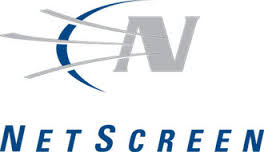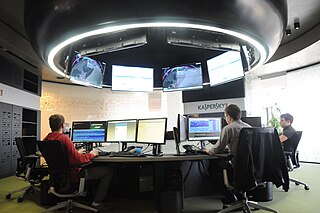Related Research Articles

Computer security, cybersecurity, or information technology security is the protection of computer systems and networks from information disclosure, theft of or damage to their hardware, software, or electronic data, as well as from the disruption or misdirection of the services they provide.

Malware is any software intentionally designed to cause disruption to a computer, server, client, or computer network, leak private information, gain unauthorized access to information or systems, deprive users access to information or which unknowingly interferes with the user's computer security and privacy. By contrast, software that causes harm due to some deficiency is typically described as a software bug. Malware poses serious problems to individuals and businesses. According to Symantec’s 2018 Internet Security Threat Report (ISTR), malware variants number has increased to 669,947,865 in 2017, which is twice as many malware variants as in 2016. Cybercrime, which includes malware attacks as well as other crimes committed by computer, was predicted to cost the world economy 6 trillion dollars in 2021, and is increasing at a rate of 15% per year.

In computing, firmware is a specific class of computer software that provides the low-level control for a device's specific hardware. Firmware, such as the BIOS of a personal computer, may contain basic functions of a device, and may provide hardware abstraction services to higher-level software such as operating systems. For less complex devices, firmware may act as the device's complete operating system, performing all control, monitoring and data manipulation functions. Typical examples of devices containing firmware are embedded systems, home and personal-use appliances, computers, and computer peripherals.
In computing, Internet Protocol Security (IPsec) is a secure network protocol suite that authenticates and encrypts the packets of data to provide secure encrypted communication between two computers over an Internet Protocol network. It is used in virtual private networks (VPNs).

A backdoor is a typically covert method of bypassing normal authentication or encryption in a computer, product, embedded device, or its embodiment. Backdoors are most often used for securing remote access to a computer, or obtaining access to plaintext in cryptographic systems. From there it may be used to gain access to privileged information like passwords, corrupt or delete data on hard drives, or transfer information within autoschediastic networks.

Juniper Networks, Inc. is an American multinational corporation headquartered in Sunnyvale, California. The company develops and markets networking products, including routers, switches, network management software, network security products, and software-defined networking technology.
In computer networking, port knocking is a method of externally opening ports on a firewall by generating a connection attempt on a set of prespecified closed ports. Once a correct sequence of connection attempts is received, the firewall rules are dynamically modified to allow the host which sent the connection attempts to connect over specific port(s). A variant called single packet authorization (SPA) exists, where only a single "knock" is needed, consisting of an encrypted packet.

An application firewall is a form of firewall that controls input/output or system calls of an application or service. It operates by monitoring and blocking communications based on a configured policy, generally with predefined rule sets to choose from. The application firewall can control communications up to the application layer of the OSI model, which is the highest operating layer, and where it gets its name. The two primary categories of application firewalls are network-based and host-based.
Cisco PIX was a popular IP firewall and network address translation (NAT) appliance. It was one of the first products in this market segment.
Netgear, Inc. is an American computer networking company based in San Jose, California, with offices in about 25 other countries. It produces networking hardware for consumers, businesses, and service providers. The company operates in three business segments: retail, commercial, and as a service provider.

Intel Active Management Technology (AMT) is hardware and firmware for remote out-of-band management of select business computers, running on the Intel Management Engine, a separate microprocessor not exposed to the user, in order to monitor, maintain, update, upgrade, and repair them. Out-of-band (OOB) or hardware-based management is different from software-based management and software management agents.
Dual_EC_DRBG is an algorithm that was presented as a cryptographically secure pseudorandom number generator (CSPRNG) using methods in elliptic curve cryptography. Despite wide public criticism, including the public identification of a backdoor, it was for seven years one of four CSPRNGs standardized in NIST SP 800-90A as originally published circa June 2006, until it was withdrawn in 2014.

The Junos operating system used in Juniper Networks network devices creates an environment for accelerating the deployment of services and applications over a single network.

NetScreen Technologies was an American technology company that was acquired by Juniper Networks for US$4 billion stock for stock in 2004.

Kaspersky Lab is a Russian multinational cybersecurity and anti-virus provider headquartered in Moscow, Russia, and operated by a holding company in the United Kingdom. It was founded in 1997 by Eugene Kaspersky, Natalya Kaspersky, and Alexey De-Monderik; Eugene Kaspersky is currently the CEO. Kaspersky Lab develops and sells antivirus, internet security, password management, endpoint security, and other cybersecurity products and services.

Bullrun is a clandestine, highly classified program to crack encryption of online communications and data, which is run by the United States National Security Agency (NSA). The British Government Communications Headquarters (GCHQ) has a similar program codenamed Edgehill. According to the Bullrun classification guide published by The Guardian, the program uses multiple methods including computer network exploitation, interdiction, industry relationships, collaboration with other intelligence community entities, and advanced mathematical techniques.

The Intel Management Engine (ME), also known as the Intel Manageability Engine, is an autonomous subsystem that has been incorporated in virtually all of Intel's processor chipsets since 2008. It is located in the Platform Controller Hub of modern Intel motherboards.
The Equation Group, classified as an advanced persistent threat, is a highly sophisticated threat actor suspected of being tied to the Tailored Access Operations (TAO) unit of the United States National Security Agency (NSA). Kaspersky Labs describes them as one of the most sophisticated cyber attack groups in the world and "the most advanced ... we have seen", operating alongside the creators of Stuxnet and Flame. Most of their targets have been in Iran, Russia, Pakistan, Afghanistan, India, Syria, and Mali.

Hardware backdoors are backdoors in hardware, such as code inside hardware or firmware of computer chips. The backdoors may be directly implemented as hardware Trojans in the integrated circuit.

Ang Cui is an American cybersecurity researcher and entrepreneur. He is the founder and CEO of Red Balloon Security in New York City, a cybersecurity firm that develops new technologies to defend embedded systems against exploitation.
References
- 1 2 Release Notes 6.3.0r27 Rev 01
- 1 2 3 Zetter, Kim (27 October 2008). "New Discovery Around Juniper Backdoor Raises More Questions About the Company". WIRED. Retrieved 15 January 2016.
- ↑ Ryan Gallagher, Glenn Greenwald (23 December 2015). "NSA Helped British Spies Find Security Holes In Juniper Firewalls" . Retrieved 27 December 2015.